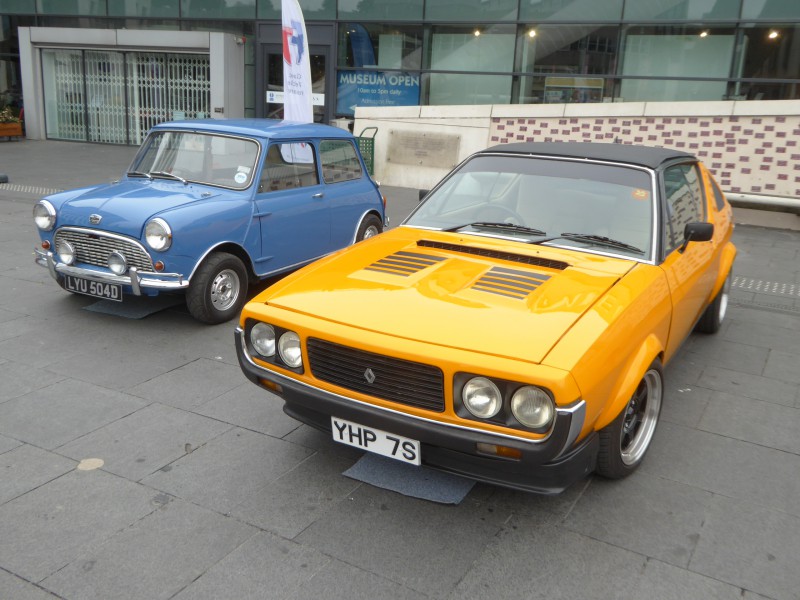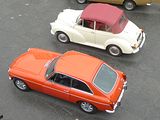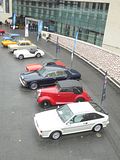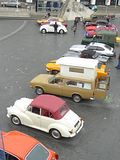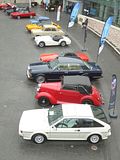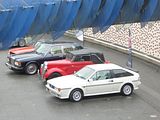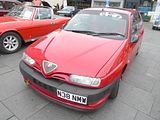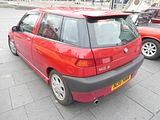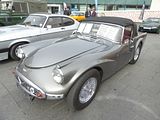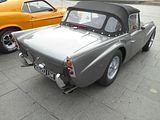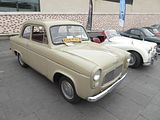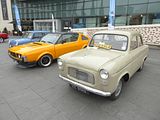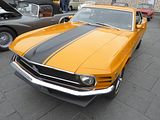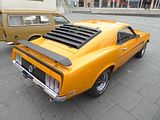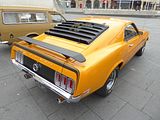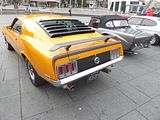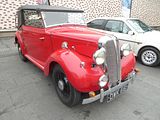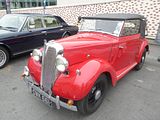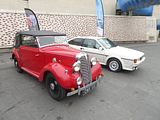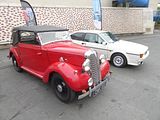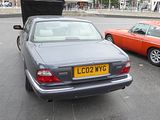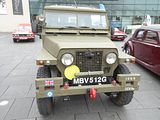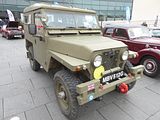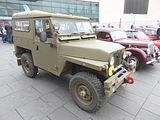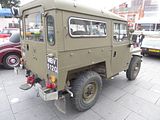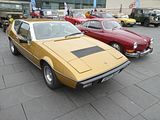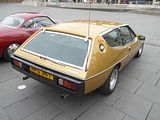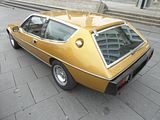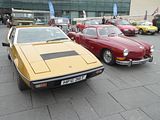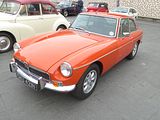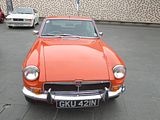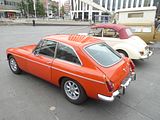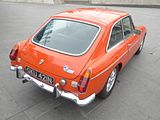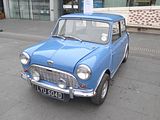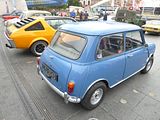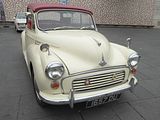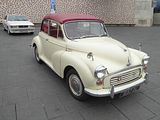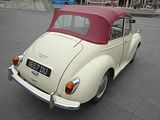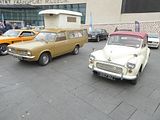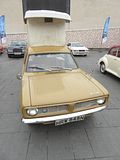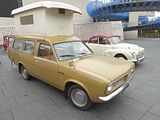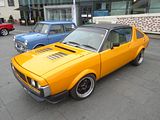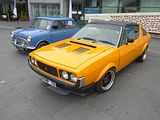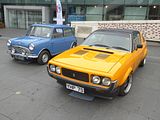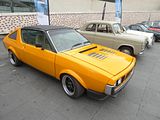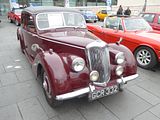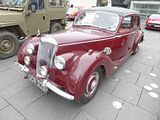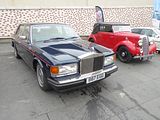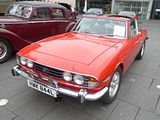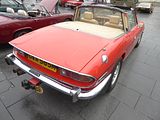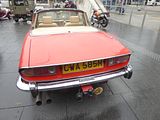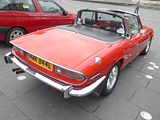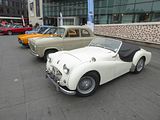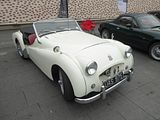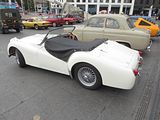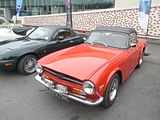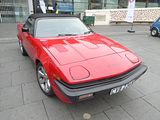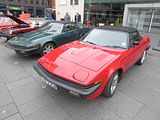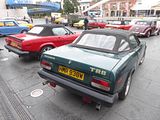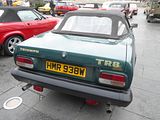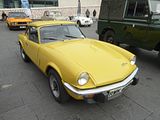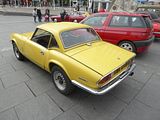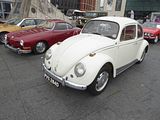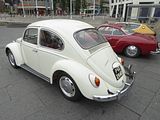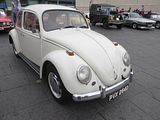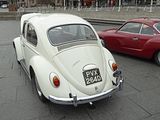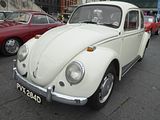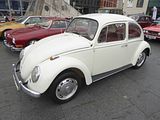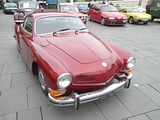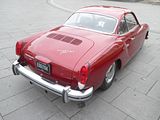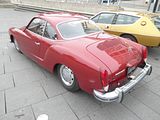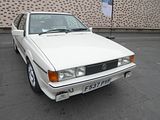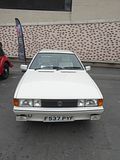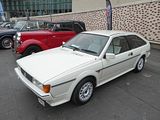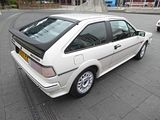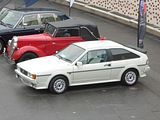I’ve attended the monthly Breakfast Club gatherings held at the Coventry Transport Museum a few times now, so know what to expect, and, perhaps more importantly what not to. There’s space for around 100 cars on the paved area in front of the Museum, as we found at the Abarth meeting there in 2017, so when you read on the Museum’s website that the event is “fully subscribed”, which they seem to claim every month, then you might reasonably expect around 100 cars. Whenever I have visited, the reality has been around a third of that total. Like all free to enter events, it is heavily dependent on the weather, and I have to make a visit when the city is bathed in glorious sunshine, so maybe they really do get 100 cars some months. Certainly for this one, when I was chatting with one of the organisers, she said that they had got a lot of no-shows, people clearly put off by the fact that the weather forecast suggested rain. That it did not start to drizzle until 10:30am, near the end of the meet shows how easy it is for some of those people who claim a spot to the potential exclusion of someone else and then don’t turn up to do, I suspect on a relatively frequent basis. I also know, even from attending an average of around a couple of times a year, that you do get a lot of the same cars at every meet. That’s true of many events, of course, but when there are only around 25 – 30 cars in total, it can feel a it too same-y. So, why did I go? Well, work had occasioned me to be in Doncaster on the Friday afternoon before this event (and this event is held on a Saturday not the more usual Sunday, note), so rather than have a very long drive all the way home only a matter of hours having driven up from London, I decided to stop off in Coventry on Friday evening, see some friends, have a bite to eat, stay over, go to the Breakfast Club and then head home on the Saturday. Here is what turned up at the event:
ALFA ROMEO
Sole Italian car on show was this Alfa Romeo 145. Never a big seller in the UK when new, these are pretty rare now, so it is always good to see one, even if this is one of the many cars that had been at the last of these events I attended back in June. When it came to replacing the 33, Alfa decided that they needed not just a five door hatch, but a three door as well, just as had been offered with the AlfaSud. The three door model, the Alfa Romeo 145 (Tipo 930A) was first to appear, making its debut on static display at the April 1994 Turin Motor Show and then at the Paris Motor Show in July. A simultaneous European commercial launch was planned for 9 September, but it was delayed until October. It was only in April 1992 that work had begun on a second car, the 146 or Tipo 930B, derived from and to be sold alongside the 145; with its more traditionally Alfa Romeo style it was aimed at a different clientele, that of the outgoing Alfa Romeo 33. The 146 premiéred in November 1994 at the Bologna Motor Show and went on sale in May 1995. The two cars shared design plans and interior components from the B-pillar forwards, but with very different looking rear ends. Based, as they were, on the Fiat Group’s Tipo Due (Type Two) platform, the 145 and 146 had a unibody structure, front MacPherson strut and rear trailing arm suspensions. A peculiarity of these cars is that they were designed to be fitted with both longitudinal engines (the older Boxers) and with transverse engines (the diesels and the Twin Spark). The former were mounted in the same configuration as on the 33 or Alfasud, that is longitudinally overhanging the front axle with the gearbox towards the cabin; the latter in the conventional transverse position with the gearbox to the left side. All engines were coupled to 5-speed manual transmissions. Steering was rack and pinion, with standard hydraulic power assistance. At launch the engine line-up for both cars comprised a 1.9-litre inline-four turbo diesel and the boxer petrol engines from the 33, in 1.3 8-valve, 1.6 8-valve and range topping 1.7 16-valve flat four forms. Depending on the market, the engines were available in either or both base and better equipped L (for “Lusso”) trim levels; L trim standard equipment was richer on larger engined cars. Flagship sport models with the two-litre 16-valve Twin Spark inline-four engine from the Alfa Romeo 155 arrived a year after the début: the 145 Quadrifoglio and 146 ti. Each of the two-litre versions had a unique trim level; both included richer standard equipment than L trims, like ABS, leather-wrapped steering wheel and shifter knob and available Recaro sport seats. The 145 Quadrifoglio (145 Cloverleaf in the UK), launched at the September 1995 Frankfurt Motor Show and on sale from October,had deep body-colour side skirts with “green cloverleaf” badges and 5-hole alloy wheels. The 146 ti went on sale in February 1996. It came with painted side skirts, a boot spoiler and 12-hole alloy wheels. Two-litre cars were equipped with stiffer suspension, uprated all-disk braking system, ABS, wider, lower-profile tires and ‘quick-rack’ direct steering (also seen on the 155, GTV and Spider) which improved responsiveness, but also compromised the turning circle. The sporty suspension set-up was harsher than many others in its category at the time, but this was in line with the Fiat Group’s marketing of Alfa Romeo as a sporting brand and it is said to have resulted in class leading handling. From January 1997 all the boxer engines were phased out in favour of 1.4, 1.6 and 1.8 versions of the Twin Spark 16-valve engine.1.8-litre cars adopted the sport chassis, steering and brakes of the Quadrifoglio/ti, and also offered some of their optional equipment such as the sport seats. At the same time the interior was updated: a new air conditioning system, a redesigned dashboard an upholstered insert were fitted. Outside changes were minor: new wheel covers and alloy wheels and a wider choice of paint colours. In late 1997 Alfa Romeo introduced the Junior, a trim level targeted at young buyers that combined the sport styling and chassis setup of the range topping models with the affordable entry-level 1.4 powertrain,later with 1.6 engine too. Based on the 1.4 L, Junior cars were distinguished by the Quadrifoglio’s side skirts with “Junior” badges, specific 15 inch alloy wheels, and by the stainless steel exhaust tip (as well as, on the 146, the boot spoiler) from the ti. A year later 1.8 and 2.0 Twin Spark engines received the updates first introduced on the Alfa Romeo 156; thanks to variable length intake manifolds the two powertrains gained 4-5 PS and reached peak torque at engine speeds some 500 rpm lower. At the Geneva Motor Show in March 1999 Alfa Romeo introduced the restyled ’99 line-up for both models. The new common rail direct injection 1.9 JTD turbo diesel replaced the 1.9 TD. The main changes outside were new, body-colour bumpers with round fog lights and narrow protection strips; the interior got new upholstery and detail trim changes such as chrome vent surrounds. Optional side airbags complemented the already available passenger and standard driver airbags. The Junior trim level was discontinued, in favour of “pack sport” option package that included side skirts, rear spoiler, alloy wheels, leather-wrapped steering wheel and sport seats, all standard features on the two-litre models. A second “pack lusso” package offered leather steering wheel, velour upholstery and mahogany wood trim. In September of the next year, at the Paris Motor Show the all-new Alfa Romeo 147 was presented Eventually, in 2000, the 145/146 cars were superseded by the all-new 147, which was a far bigger commercial success, with its acclaimed styling front end and improved quality. Still, many enthusiasts feel that it lost a little of the special feel and Alfa Romeo that the 145 had. 221,037 145s and 233,295 146s were built, Most of the survivors are the top of the range 2.0 litre Cloverleaf model, and that is what this one was.
DAIMLER
The SP250 “Dart” was quite unlike any previous Daimler model, the marque having a history of producing a series of luxurious saloon and open topped models. But by the mid 1950s, the once proud Coventry marque was in trouble, with a range of cars which were expensive and just not selling. New models were seen as a potential way of changing things around, so shortly after being appointed Managing Director of BSA’s Automotive Division in 1956, Edward Turner was asked to design a saloon car powered by a new V8 engine. The engine drawings were finalised by March 1958 but the saloon prototype, project number DN250, was not available for examination by the committee formed in 1958 to report on the feasibility of the V8 cars. The committee’s evaluation centred on the prototypes being tested at the time, which were for the SP250 sports car project. according to the feasibility study conducted by the committee, the SP250 would generate a profit of more than £700,000 based on a projection of 1,500 cars being sold in the first year of production and 3,000 cars per year for the second and third years of production. Two-thirds of the sales of the car were expected to be in the United States. The study also determined that the body should be made from fibreglass, with shorter time to the beginning of production, tooling costs of £16,000 as opposed to £120,000 for steel bodies, and lower cost to change the styling. That meant that the car was able to be launched at the 1959 New York Show, christened the Daimler Dart. Chrysler, whose Dodge division owned the trademark for the “Dart” model name, ordered Daimler to change the name under threat of legal action. With little time to come up with a new name, Daimler used the project number, SP250, as the model number. The car certainly looked quite unlike previous Daimlers, but whether that was a good thing is less clear as the SP250 won “The Ugliest Car” via vote at that 1959 show. That was not the only problem with the car, either. The original version, later called the A-spec, could reach a speed of 120 mph, but the chassis, a “14-gauge ladder frame with cruciform bracing” based on the Triumph TR3, flexed so much that doors occasionally came open, marring its reputation. The car featured the smaller of the two hemi-head V8 engines which Edward Turner had designed. 2547cc in capacity, it was a V8, iron block, OHV unit, with a single central camshaft operated valves through short pushrods with double heavy-duty valve springs, aluminium alloy hemispherical cylinder heads, and twin SU carburettors which meant it put out 140 bhp.The manual gearbox, the first of the type used by Daimler since they started using the pre-selector type across their range in the 1930s,, was reverse-engineered from the Standard gearbox used in the Triumph TR3A. Early examples of the car were not particularly reliable. Sales were slow, initially, and Daimlers problems were compounded when, not long after they had been acquired by Jaguar, an in-house rival in the form of the E Type arrived on the scene. New bosses at Jaguar did not kill off the SP250, though, but they were immediately concerned about the chassis flex. They brought out the B-spec. version with extra outriggers on the chassis and a strengthening hoop between the A-posts. There were also other detail improvements, including an adjustable steering column. Bumpers had originally been an optional extra. With the basic specification not including full bumpers, the A-spec. cars have two short, chromium-plated ‘whiskers’ on the body on either side of the front grille and two short, vertical bumpers, or “overriders” at the rear, which were not included if the rear bumper was optioned. B-spec. and the later C-spec. cars do not have the ‘whiskers’ that A-spec. have and some do not have the optional front bumper, so there is very little front protection for these cars. A planned Coupe version of the car, the DP250 never got beyond the prototype phase, and Ogle Design’s proposal for a Coupe version was not taken up, the styling for that concept ending up forming the Reliant Scimitar GT. The SP250 ended production in 1964. Just 2,654 SP250s were produced in five years of production, far short of the projection of 3,000 per year by the second year of production. Jaguar did built a prototype replacement under project number SP252 with a neater body style but decided not to proceed with production, as they figured that the cost to build the SP252 would have been greater than that of Jaguar’s popular and more expensive E-Type, thereby creating internal competition from a product with no practical profit margin and with uncertain market acceptance. These days, surviving SP250s are viewed rather more positively than they were when new, and a certain Quentin Willson, who has owned one for many years, is particularly positive about the car’s merits.
FORD
Ford had a habit of keeping a model in production alongside its replacement, so when the 105E Anglia was launched in the autumn of 1959, the previous bodyshape stayed in the range, in 4 door guise as the 107E Prefect and in stripped out bottom of the range entry level new car motoring, the 100E Popular, as seen here. In 1960, the manufacturer’s recommended retail price of £494 was equivalent to 26 weeks’ worth of the average UK wage. The £100 charged in 1935 for the Model Y and the £1,299 charged for the Ford Escort Popular in 1975 both also amounted to 26 weeks’ worth of average wage for the years in question. In the 1950s, however, the country had been undergoing a period of above average austerity: in 1953 the car’s £390 sticker price represented 40 weeks’ worth of the average UK wage. The Popular 100E was powered by a strengthened 1172 cc sidevalve engine producing 36 bhp which gave it a top speed of 69.9 mph, acceleration from 0–50 mph in 19.6 seconds and a fuel consumption of 33.2 mpg. The brakes were now hydraulic with 8 in drums all round. The new Popular offered 1,000 mile service intervals, like its predecessor, but it only had 13 grease points as against its predecessor’s 23, and 28 for the pre-war cars. The basic model stripped out many fittings from the Anglia but there was a large list of extras available and also a De Luxe version which supplied many as standard. 126,115 Popular 100Es were built. In later years, these cars became popular as hot rods since the late 1950s when people started drag racing them due to their lightweight construction. This practice started in the United States but became the definitive British hot rod, which it still is today.
This very distinctive 1969 Ford Mustang is another of the cars which I have seen at this event a number of times before, though it was not present back in June. For the first two years of Mustang production, the car’s appearance had changed little, but from 1967, Ford made the annual model updates which were common among all US manufacturers at the time. Whilst the 1967 and 1968 changes were largely concentrated on the front end, and the car was still visually quite like the very first 1964.5 models, the 1969 model year restyle “added more heft to the body” with the body length extended by 3.8 inches on the same 108 inch wheelbase, width increased by almost half an inch, and the Mustang’s “weight went up markedly too.” 1969 was the first model to use quad headlamps placed both inside and outside the grille opening. The corralled grille pony was replaced with the pony and tribars logo, set off-centre to the drivers side. The car was longer than previous models and sported convex rather than concave side panels. The fastback body version was renamed Sportsroof, styled as SportsRoof in Ford’s literature. The 1969 model year saw the introduction of the Mach 1, with a variety of powerplants options and many new styling and performance features. Distinctive reflective striping was placed along the body sides, with a pop-open fuel cap, dual exhausts, matte-black hood with simulated air scoop and NASCAR-style cable and pin tiedowns. It used steel wheels with bold-lettered Goodyear Polyglas tyres. A functional “shaker” bonnet scoop – which visibly vibrated by being attached directly to the air cleaner through a hole in the bonnet – was available, as were tail-mounted wing and chin spoilers and rear window louvered blackout shade. The Mach 1 featured a deluxe interior with simulated wood trim, high backed seats, extra sound deadening, remote sports mirrors and other comforts. The Mach 1 proved popular with buyers with 72,458 cars sold through 1969. The Boss 302 was created to meet Trans Am rules and featured distinctive hockey-stick stripes, while the understated Boss 429 was created to homologate the Boss 429 engine (based on the new Ford 385 series engine) for NASCAR use. The two Boss models received fame on the track and street and to this day they still demand premium pricing for their pedigree. 1628 Boss 302’s and 859 Boss 429’s were sold through 1969 – making these vehicles somewhat rare. A new “luxury” model became available starting for 1969, available in only the hardtop body style. The ‘Grande’ featured a soft ride, 55 pounds of extra sound deadening, as well as deluxe interior with simulated wood trim. It was popular with buyers with 22182 units sold through 1969. Amidst other special editions, the 1969 Mustang E was offered for those desiring high mpg. The 1969 Limited Edition Mustang E was a rare (about 50 produced) fastback special model designed for economy. It came with a six-cylinder 4.1 litre engine, a high stall torque converter for the standard automatic transmission and a very low, 2.33:1 rear axle ratio. Mustang E lettering on the rear quarters identified the special Mustang E. Air conditioning was not available on the ‘E’ model. The Mustang GT was discontinued in 1969 due to poor sales versus the success of the new Mach 1 with only 5396 GT models sold that year. Although 1969 continued with many of the same basic V8 engines available on 1968 models, notably a now revised 302 cu in (4.9 litre) Windsor engine with 220 hp, the 390 cu in (6.4 litre) FE with 320 hp and the recently launched 428 cu in (7.0 litre) Cobra Jet engine (with or without Ram-Air) with an advertised 335 hp, a variety of revised options and changes were introduced to keep the Mustang fresh and competitive including a new performance V8 available in 250 hp or 290 hp tune known as the 351 cu in (5.8 litre) Windsor (351W), which was effectively a stretched and revised 302 cu in (4.9 litre) to achieve the extra stroke. The 428 cu in (7.0 litre) Cobra Jet engine continued unchanged in the 1969 and 1970 model years and continued to be advertised at just 335 hp despite being closer to 410 hp. However, whenever a V or W axle was ordered (3.90 or 4.30 locking ratio) on any Cobra Jet Mustang, this kicked in various engine improvements which were designed to make the engine more reliable on the strip. These improvements included an engine oil cooler (which resulted in AC not remaining an option), stronger crankshaft and conrods and improved engine balancing and was named the ‘Super Cobra Jet’. On the order form, these improvements were later referred to as ‘Drag Pack’. Today, these models request a premium price despite offering no notable performance increase other than provided by their unique axle ratios. The 1969 Shelby Mustang was now under Ford’s control and made to look vastly different from regular production Mustangs, despite now being built inhouse by Ford. The custom styling included a fibreglass front end with a combination loop bumper/grille that increased the car’s overall length by 3 inches as well as five air intakes on the bonnet. Two models were available, GT-350 (with a 351 cu in (5.8 litre) Windsor (351W) producing 290 hp and GT-500 (with the 428 cu in (7.0 litre) Cobra Jet engine), in both sportsroof or convertible versions. All 1969–1970 Shelby Mustangs were produced in 1969. Because of dwindling sales, the 789 remaining 1969 cars were given new serial numbers and titled as 1970 models. They had modified front air dam and a blackout paint treatment around the hood scoops. The 1970 model year Mustangs were restyled again, to be less aggressive and therefore returned to single headlamps which were moved to the inside of the grille opening with ‘fins’ on the outside of the grille sides. Some felt the aggressive styling of the 1969 model hurt its sales and this view prompted the headlamp revisions and simplification of other exterior styling aspects. It’s worth noting though that 1969 model year sales exceeded those of 1970. The rear fender air scoops were removed and the taillight panel was now flat instead of concave as seen on 1969 models. The interior options remained mostly unchanged.
HILLMAN
Very much a local product, the Hillman Minx, seen here in Convertible guise, would have been made at Ryton, just a few miles away from this location. Hillman used the Minx name for nearly 4 decades, during which time it appeared on a number of different cars, all of them very much aimed at the family car market. The original Minx was introduced in 1932 with a pressed-steel body on separate chassis and 30 bhp 1185 cc engine. It was upgraded with a four-speed transmission in 1934 and a styling upgrade, most noticeably a slightly V-shaped grille. For 1935, synchromesh was added but the range was otherwise similar. The 1936 model got a new name, the Minx Magnificent, and a restyle with much more rounded body. The chassis was stiffened and the engine moved forwards to give more passenger room. The rear panel, hitherto vertical, was now set at a sloping angle, and the manufacturers offered the option of a folding luggage grid which could be attached to the rear panel and was available for “two pounds, seven shillings and sixpence” (slightly under £2.40) painted. A Commer-badged estate car was added to the range. The final pre-war model was the 1938 Minx. There were no more factory-built tourers but some were made by Carbodies. The car was visually similar to the Magnificent, with a different grille, and access to the luggage boot was external unlike its predecessor where it was accessed by folding down the rear seat. There were two saloon models in the range, the basic “Safety” model with simple rexine trim instead of leather, no opening front quarterlights, and less luxurious trim levels. The De Luxe model had leather trim, opening quarterlights, extra trim pads, and various other comfort benefits. The 1938 model was not the final iteration before the outbreak of war, however, as the 1939 model was considerably different mechanically, with virtually the entire drive-train improved to the extent that few parts are interchangeable with the 1938 model. This includes gearbox, differential, half shafts, steering box, and a great many other mechanical and cosmetic changes. Even the front grille, which to the casual eye looks almost identical to the 1938 model, became a pressed alloy component rather than a composite. This Tourer model dates from 1938.
JAGUAR
Not quite hitting the event’s rule of display cars needing to be at least 20 years old was this rather elegant Jaguar XJ8. This is from the X308 generation, which was based on the earlier X300 range. The “X300” model was the first XJ produced entirely under Ford ownership, and can be considered an evolution of the outgoing XJ40 generation. Like all previous XJ generations, it featured the Jaguar independent rear suspension arrangement. The design of the X300 placed emphasis on improved build quality, improved reliability, and a return to traditional Jaguar styling elements. At the car’s launch in October 1994 at the Paris Motor Show, Jaguar marketing material made use of the phrase “New Series XJ” to describe the X300 models. The X300 series represented the result of a £200 million facilities renewal program by Ford. which included the introduction of state-of-the-art automated body welding robots manufactured by Nissan. Aesthetically, the X300 received several updates in the design refresh led by Geoff Lawson in 1991. The mostly flat bonnet of the XJ40 was replaced with a fluted, curvaceous design that accentuated the four separate round headlamps. Rear wings were reshaped to accommodate the new wrap-around rear light clusters. Also, the separate black-rubber bumper bar of the XJ40 were replaced with a fully integrated body-coloured bumper. The interior of the X300 was similar to that found in the XJ40, with some revisions. The seats were updated to have a more rounded profile, wood trim was updated with bevelled edges, and the steering wheel was redesigned. Jaguar’s V12 engine and AJ6 inline-six (AJ16) engine were both available in various X300 models, although they received significant updates. Both engines were fitted with distributorless electronic engine management systems. The Jaguar X308 first appeared in 1997 and was produced until 2003. It was an evolution of the outgoing X300 platform, and the exterior styling is nearly identical between the two generations, though there are quite a few detailed differences if you know what to look for. The major change was the under the bonnet. Having discontinued production of both the AJ16 inline-six and V12 engines, Jaguar offered only its newly designed V8 engine (named the AJ-V8.) It was available in either 3.2 or 4.0 litre forms, although certain markets, such as the United States, only received cars powered by the 4.0 litre version. The 4.0 litre version was also supercharged in certain models. Equipment levels were notably more generous than had previously been the case.
LAND ROVER
There were a couple of ex Army Series 2 Land Rover models here. One was the “standard” version and there was also a “Lightweight”. In the early 1960s both the Royal Marines, then largely based aboard commando carriers, and the British Army required a vehicle that could be carried by air. They had taken delivery of the Westland Wessex helicopter, which could carry a 2,500 lb (1,134 kg) load slung beneath. The smallest Land Rover available at the time was a Series IIA 88 inch (2235 mm) wheelbase, which was too heavy. Land Rover began work on a lightweight version to fit the specifications in 1965. A new modification to the basic Series IIA was devised by making many body components easily detachable and removing many non-essential items. The result was the Land Rover Half-Ton, known widely as the Lightweight or Airportable. In practice, to reduce weight sufficiently for the helicopters of the day to lift them in combat conditions, the tilt (roof) and sticks, the upper parts of the body, the doors and windscreen were removed, to be refitted later. The most significant change, however, was a reduction in width by 4 inch (100 mm), by redesigning the standard Series IIA axles and fitting shorter half-shafts, which meant it would fit on a standard pallet. Complete, the Lightweight IIA weighed 2,650 lb (1,202 kg), over the specified weight. The term Lightweight appears misleading as a standard 88 Land Rover weighed 1,318 kg (2,906 lb), but the higher total weight was due to the various frame reinforcement required for military usage. However, with the removable body panels taken-off it was below the limit. Since improvements to the helicopters meant more lift was available, the MoD accepted it for use. The main applications were actually to be shipped by cargo aircraft or stacked on train wagons, with helicopter transport a rare occurrence. Although a very few prototypes had been built between 1965 and 1967, and about six pre-production models early in 1968, ‘Lightweight’ Series IIA quantity production began on 11 November 1968, with a total of 15 vehicles being produced on that day. Total production of Series IIa ‘Lightweights’ was between 1,500 and 2,000 vehicles. Later Series IIa models had the headlamps moved out into a revised front wing, to comply with revised lighting regulations. It is easy to confuse later Series IIa models with the Series III, though nothing was changed on these vehicles other than the location of the headlamps. The Series IIA Lightweight was replaced by the Series III Lightweight in 1972, soon after the replacement of the civilian Series IIA with the Series III. The vehicle remained in essence the same, with a few relatively minor changes – there are detail differences to the chassis; and a revised gearbox had synchromesh on second through fourth gears instead of just third and fourth. In the electrical department the Series III was fitted with an alternator in place of the dynamo of the Series IIa; the new indicator switch incorporates a headlamp flasher and horn; and the ignition switch was now fitted in a new steering column cowl instead of on the dashboard. The Lightweight did retain the earlier Series IIa metal dashboard even after the upgrade. Around 1980, in line with civilian models, the engine had five main bearings instead of three. Over 20 countries besides the British Army used the Lightweight. Left hand drive (LHD) models were used by the British Armed Forces in support of their NATO commitments. Many LHD models were used by the Dutch military and were predominantly fitted with diesel engines. Lightweight production ended in 1984, when the parent Land Rover Series III was replaced by the models 90 and 110. A total of 37,897 Lightweights, petrols and diesels, were built.
LOTUS
Another of those repeat attendees is this striking gold coloured Elite 503. Announced in 1974, the Type 75 Elite was the first of a new generation of Lotus cars which represented a concerted push up-market. The imposition of VAT had effectively killed off the market for the range of models that Lotus had hitherto produced as kit cars, and the only way to stay profitable was to produce something which could sold at higher prices. So whilst Lotus would tell you that the Elite was a replacement for the Lotus Elan Plus 2, it was more accurate to say that it was a rival for cars like the Reliant Scimitar GTE and Lancia Beta HPE. The styling was quite unlike anything that Lotus had produced before, with distinctive wedge lines penned by Oliver Winterbottom which hid the fact that the bodies were produced out of two separate glassfibre moulds and they had to join up in the middle around the waistline. The shooting brake style, with a hatchback as well as the fact that the Elite had 4 seats made it reasonably practical. luggage compartment. Mechanically there were fewer surprise. It was front engined with rear wheel drive, and had 4-wheel independent suspension using coil springs. The Elite was Lotus’ first car to use the 907 aluminium-block 4-valve, DOHC, four-cylinder, 1973cc, developing 155 bhp. which had previously been used in the Jensen-Healeys, where all the reliability issues had been found) The 907 engine ultimately became the foundation for the 2.0 litre and 2.2 litre Lotus Esprit powerplants, the naturally aspirated 912 and the turbocharged 910. The Elite was fitted with a 4 or 5 speed gearbox and from January 1976 automatic transmission was optional. The Elite had a claimed drag co-efficient of 0.30 and at the time of launch it was the world’s most expensive four cylinder car. Elites were available in 4 main specification variations, 501, 502, 503, and later on 504. The 501 was the ‘base’ version. The 502 added air conditioning, the 503 had power steering and the 504 added automatic transmission. The Elite was the basis for a coupe model, the Eclat which was launched in October 1975. Facelifted versions of both came in 1980, with a larger 2.2 litre engine and refinements to the trim. The Elite would live a couple of years in this form, but market interest shifted to the Coupe and when this was given a more significant revision a couple of years later, and a new name of Excel, the Elite was dropped from the range. Although 2535 of them were made, they are rare these days.
MG
No surprise that there was an MGB here, as this is probably the most popular classic of all in the UK, thanks to a plentiful supply of cars and the fact that mechanically it is quite simple. With excellent availability of just about every part you might need including a complete bodyshell, many of these cars have enjoyed a new lease of life. Launched in October 1962, the MGB was produced for the next 18 years and it went on to become Britain’s best selling sports car. When first announced, the MGB was an innovative, modern design, with a monocoque structure instead of the traditional body-on-frame construction used on both the MGA and MG T-types and the MGB’s rival, the Triumph TR series, though components such as the brakes and suspension were developments of the earlier 1955 MGA and the B-Series engine had its origins back in 1947. The lightweight design reduced manufacturing costs while adding to overall vehicle strength, and with a 95hp 3-bearing 1798cc engine under the bonnet, performance was quite respectable with a 0–60 mph time of just over 11 seconds. The car was rather more civilised than its predecessor, with wind-up windows now fitted as standard, and a comfortable driver’s compartment offered plenty of legroom. The roadster was the first of the MGB range to be produced. The body was a pure two-seater but a small rear seat was a rare option at one point. By making better use of space the MGB was able to offer more passenger and luggage accommodation than the earlier MGA while being 3 inches shorter overall. The suspension was also softer, giving a smoother ride, and the larger engine gave a slightly higher top speed. The four-speed gearbox was an uprated version of the one used in the MGA with an optional (electrically activated) overdrive transmission. A five-bearing engine was introduced in 1964 and a number of other modifications crept into the specification. In late 1967, sufficient changes were introduced for the factory to define a Mark II model. Alterations included synchromesh on all 4 gears with revised ratios, an optional Borg-Warner automatic gearbox, a new rear axle, and an alternator in place of the dynamo with a change to a negative earth system. To accommodate the new gearboxes there were significant changes to the sheet metal in the floorpan, and a new flat-topped transmission tunnel. US market cars got a new safety padded dashboard, but the steel item continued for the rest of the world. Rostyle wheels were introduced to replace the previous pressed steel versions in 1969 and reclining seats were standardised. 1970 also saw a new front grille, recessed, in black aluminium. The more traditional-looking polished grille returned in 1973 with a black “honeycomb” insert. Further changes in 1972 were to the interior with a new fascia. To meet impact regulations, in late 1974, the chrome bumpers were replaced with new, steel-reinforced black rubber bumpers, the one at the front incorporating the grille area as well, giving a major restyling to the B’s nose, and a matching rear bumper completed the change. New US headlight height regulations also meant that the headlamps were now too low. Rather than redesign the front of the car, British Leyland raised the car’s suspension by 1-inch. This, in combination with the new, far heavier bumpers resulted in significantly poorer handling. For the 1975 model year only, the front anti-roll bar was deleted as a cost-saving measure (though still available as an option). The damage done by the British Leyland response to US legislation was partially alleviated by revisions to the suspension geometry in 1977, when a rear anti-roll bar was made standard equipment on all models. US emissions regulations also reduced horsepower. In March 1979 British Leyland started the production of black painted limited edition MGB roadsters for the US market, meant for a total of 500 examples. Due to a high demand of the limited edition model, production ended with 6682 examples. The United Kingdom received bronze painted roadsters and a silver GT model limited editions. The production run of homemarket limited edition MGBs was split between 421 roadsters and 579 GTs. Meanwhile, the fixed-roof MGB GT had been introduced in October 1965, and production continued until 1980, although export to the US ceased in 1974. The MGB GT sported a ground-breaking greenhouse designed by Pininfarina and launched the sporty “hatchback” style. By combining the sloping rear window with the rear deck lid, the B GT offered the utility of a station wagon while retaining the style and shape of a coupe. This new configuration was a 2+2 design with a right-angled rear bench seat and far more luggage space than in the roadster. Relatively few components differed, although the MGB GT did receive different suspension springs and anti-roll bars and a different windscreen which was more easily and inexpensively serviceable. Although acceleration of the GT was slightly slower than that of the roadster, owing to its increased weight, top speed improved by 5 mph to 105 mph because of better aerodynamics. 523,826 examples of the MGB of all model types were built, and although many of these were initially sold new in North America, a lot have been repatriated here.
MINI
Early Issigonis designed Minis have acquired quite a cult following, and the values of the very early cars have amazed more or less everyone, often exceeding the price of the sough after Cooper S versions. The car seen is early, but not that early, dating from 1966. It is a Super De Luxe, identified by the small chrome trim pieces that go from the overriders to the corners of the bumpers. Mechanically, the Super De Luxe was the same as the cheaper models, still with the 848cc engine, the larger 998cc unit would not come til the launch of the Mark 2 the following year.
MORRIS
No surprise to see the evergreen Morris Minor here as this is a very popular classic. The Minor was conceived in 1941. Although the Nuffield Organization was heavily involved in war work and there was a governmental ban on civilian car production, Morris Motors’ vice chairman, Miles Thomas, wanted to prepare the ground for new products to be launched as soon as the war was over. Vic Oak, the company’s chief engineer, had already brought to Thomas’ attention a promising junior engineer, Alec Issigonis, who had been employed at Morris since 1935 and specialised in suspension design but he had frequently impressed Oak with his advanced ideas about car design in general. Issigonis had come to Oak’s particular attention with his work on the new Morris Ten, which was in development during 1936/7. This was the first Morris to use unitary construction and was conceived with independent front suspension. Issigonis designed a coil-sprung wishbone system which was later dropped on cost grounds. Although the design would later be used on the MG Y-type and many other post-war MGs the Morris Ten entered production with a front beam axle. Despite his brief being to focus on the Ten’s suspension Issigonis had also drawn up a rack and pinion steering system for the car. Like his suspension design this was not adopted but would resurface in the post-war years on the MG Y-type, but these ideas proved that he was the perfect candidate to lead the design work on a new advanced small car. With virtually all resources required for the war effort, Thomas nonetheless approved the development of a new small family car that would replace the Morris Eight. Although Oak (and Morris’ technical director, Sidney Smith) were in overall charge of the project it was Issigonis who was ultimately responsible for the design, working with only two other draughtsmen. Thomas named the project ‘Mosquito’ and ensured that it remained as secret as possible, both from the Ministry of Supply and from company founder William Morris (now Lord Nuffield), who was still chairman of Morris Motors and, it was widely expected, would not look favourably on Issigonis’ radical ideas. Issigonis’ overall concept was to produce a practical, economical and affordable car for the general public that would equal, if not surpass, the convenience and design quality of a more expensive car. In later years he summed up his approach to the Minor; that he wanted to design an economy car that “the average man would take pleasure in owning, rather than feeling of it as something he’d been sentenced to” and “people who drive small cars are the same size as those who drive large cars and they should not be expected to put up with claustrophobic interiors.” Issigonis wanted the car to be as spacious as possible for its size and comfortable to drive for inexperienced motorists. Just as he would with the Mini ten years later, he designed the Mosquito with excellent roadholding and accurate, quick steering not with any pretence of making a sports car, but to make it safe and easy to drive by all. As work proceeded, there were plenty of battle to overcome, to get Issigonis’ ideas approved, and not all of them were. The production car, called the Minor was launched at the British Motor Show at Earls Court in London on October 27, 1948. At the same show Morris also launched the new Morris Oxford and Morris Six models, plus Wolseley variants of both cars, which were scaled-up versions of the new Minor, incorporating all the same features and designed with Issigonis’ input under Vic Oak’s supervision. Thus Issigonis’ ideas and design principles underpinned the complete post-war Morris and Wolseley car ranges. The original Minor MM series was produced from 1948 until 1953. It included a pair of four-seat saloons, two-door and (from 1950) a four-door, and a convertible four-seat Tourer. The front torsion bar suspension was shared with the larger Morris Oxford MO, as was the almost-unibody construction. Although the Minor was originally designed to accept a flat-4 engine, late in the development stage it was replaced by a 918 cc side-valve inline-four engine, little changed from that fitted in the 1935 Morris 8, and producing 27.5 hp and 39 lbf·ft of torque. This little engine pushed the Minor to just 64 mph but delivered 40 mpg. Brakes were four-wheel drums. Early cars had a painted section in the centre of the bumpers to cover the widening of the production car from the prototypes. This widening of 4 inches is also visible in the creases in the bonnet. Exports to the United States began in 1949 with the headlamps removed from within the grille surround to be mounted higher on the wings to meet local safety requirements. In 1950 a four-door version was released, initially available only for export, and featuring from the start the headlamps faired into the wings rather than set lower down on either side of the grille. The raised headlight position became standard on all Minors in time for 1951. From the start, the Minor had semaphore-type turn indicators, and subsequent Minor versions persisted with these until 1961 An Autocar magazine road test in 1950 reported that these were “not of the usual self-cancelling type, but incorporate[d] a time-basis return mechanism in a switch below the facia, in front of the driver”. It was all too easy for a passenger hurriedly emerging from the front passenger seat to collide with and snap off a tardy indicator “flipper” that was still sticking out of the B-pillar, having not yet been safely returned by the time-basis return mechanism to its folded position. Another innovation towards the end of 1950 was a water pump (replacing a gravity dependent system), which permitted the manufacturer to offer an interior heater “as optional equipment”. When production of the first series ended, just over a quarter of a million had been sold, 30 per cent of them the convertible Tourer model. In 1952, the Minor line was updated with an Austin-designed 803 cc overhead valve A-series engine, replacing the original side-valve unit. The engine had been designed for the Minor’s main competition, the Austin A30, but became available as Austin and Morris were merged into the British Motor Corporation. The new engine felt stronger, though all measurements were smaller than the old. The 52 second drive to 60 mph was still calm, with 63 mph as the top speed. Fuel consumption also rose to 36 mpg. An estate version was introduced in 1952, known as the Traveller (a Morris naming tradition for estates, also seen on the Mini). The Traveller featured an external structural ash (wood) frame for the rear bodywork, with two side-hinged rear doors. The frame was varnished rather than painted and a highly visible feature of the body style. Commercial models, marketed as the Morris Quarter Ton Van and Pick-up were added in May 1953. Rear bodies of the van versions were all steel. The 4-seat convertible and saloon variants continued as well. The car was again updated in 1956 when the engine was increased in capacity to 948 cc. The two-piece split windscreen was replaced with a curved one-piece one and the rear window was enlarged. In 1961 the semaphore-style trafficators were replaced by the flashing direction indicators, these were US-style red at the rear (using the same bulb filament as the brake lamp) and white at the front (using a second brighter filament in the parking lamp bulb) which was legal in the UK and many export markets at the time (such as New Zealand). An upmarket car based on the Minor floorpan using the larger BMC B-Series engine was sold as the Riley One-Point-Five/Wolseley 1500 beginning in 1957: versions of this Wolseley/Riley variant were also produced by BMC Australia as the Morris Major and the Austin Lancer. In December 1960 the Morris Minor became the first British car to sell more than 1,000,000 units. To commemorate the achievement, a limited edition of 350 two-door Minor saloons (one for each UK Morris dealership) was produced with distinctive lilac paintwork and a white interior. Also the badge name on the side of the bonnet was modified to read “Minor 1,000,000” instead of the standard “Minor 1000”. The millionth Minor was donated to the National Union of Journalists, who planned to use it as a prize in a competition in aid of the union’s Widow and Orphan Fund. The company, at the same time, presented a celebratory Minor to London’s Great Ormond Street Hospital for Sick Children, but this car was constructed of cake. The final major upgrades to the Minor were made in 1962. Although the name Minor 1000 was retained, the changes were sufficient for the new model to be given its own ADO development number. A larger version of the existing A-Series engine had been developed in conjunction with cylinder head specialist Harry Weslake for the then new ADO16 Austin/Morris 1100 range. This new engine used a taller block than did the 948 cc unit, with increased bore and stroke bringing total capacity up to 1,098 cc. Although fuel consumption suffered moderately at 38 mpg, the Minor’s top speed increased to 77 mph with noticeable improvements in low-end torque, giving an altogether more responsive drive. Other changes included a modified dashboard layout with toggle switches, textured steel instrument binnacle, and larger convex glove box covers. A different heater completed the interior upgrade, whilst the larger combined front side/indicator light units, common to many BMC vehicles of the time, were fitted to the front wings. These now included a separate bulb and amber lens for indicators while larger tail lamp units also included amber rear flashers. During the life of the Minor 1000 model, production declined. The last Convertible/Tourer was manufactured on 18 August 1969, and the saloon models were discontinued the following year. Production of the more practical Traveller and commercial versions ceased in 1972, although examples of all models were still theoretically available from dealers with a surplus of unsold cars for a short time afterwards. 1,619,857 Minors of all variants were ultimately sold and to be seen here was a nice example of the Tourer.
One of the most unusual cars of the morning, albeit one I have seen at this event a number of times before, was this SunTor converted Morris Marina. SunTor of Devon had offered motor caravan conversions of previous BMC vans, so when the Marina Van was added to the range in 1974, it was not long before they applied their skill and creativity to this model as well, producing something that was smaller and cheaper than the popular VW Type 2 based Camper vans, but still with sufficient space for a couple of occupants to sleep in, thanks to the front seats being able to recline fully to form the double bed. There was a fully-lined, spring-loaded elevating roof and a wealth of built-in cupboards in the rear. Raising the roof provided not only 6′ internal headroom, but also valuable extra storage space. Both the front and rear seats could be reclined to form a 6′ 4″ x 4′ double bed, with 4″-thick Dunlopillo cushioning. The front seats could also be reversed to face the rear to provide a dining area, in conjunction with the tables formed by the top-hinged locker doors. The kitchen area came equipped with a cooker with two burners and grill, a compact sink fed by an under-floor water tank and hand-drawn pump, plus ample storage space afforded by the built-in cupboards. Fitted carpets and tailored curtains completed the scene. Early cars, such as this one were badged Morris, but later ones adopted Austin badging when BL decided that all commercial vehicles should be Austins. The models all had the 1275cc A Series engine, which was also the case for the Van, so rapid they were not, but the model filled a market need and was quite popular in its day. There are not many left now.
RENAULT
A car I certainly had not seen at this event before, and a real rarity was this R17 Gordini. Effectively a coupe version of the Renault R12 saloon, there were two distinct models, the R15 and R17, both launched at the same time, a the 1971 Paris Show. The main visual differences between the two cars were their headlight configuration (the 15 had two rectangular headlights whereas the 17 had four round headlights) and their rear side windows. The R15 TL had the same 1289cc engine as the R12, whereas the R15 TS and R17 TL had a more powerful 1565cc engine from the Renault R16 TL and the top of the range R17TS had more power from its fuel injected engine – 109 bhp, rather than 90bhp and a five speed gearbox. At the 1974 Paris Motor Show, the R17TS was renamed the “17 Gordini”. This new name was an attempt to fill the gap left by the recently discontinued Renault 12 Gordini, nothing was changed beyond the badging. There was a minor facelift announced in March 1976, most noticeable on the grille of the 15, where the chrome edge surround was replaced with a body-coloured one: the headlights were enlarged and brought forward to a position approximately flush with the surround. The grille of the 17 also lost its chrome surround, although on both cars the partially chrome front bumper now curved up at the edges to roughly half-way up the height of the grille. The R15 and R17 remained in production until summer 1979 when they were both replaced by the Renault Fuego. They were reasonably popular when new, though they cost rather more than the Ford Capri, the main UK market rival, but there are only a handful of survivors in the UK, so this example of the facelifted style was a real rarity.
RILEY
The Riley RM Series was the last model developed independently by Riley. RM vehicles were produced from 1945, after the Second World War, until the 1952 merger of Riley’s parent company, the Nuffield Organisation with Austin to form BMC. They were originally made in Coventry, but in 1949 production moved to the MG works at Abingdon. The RM models were marketed as the Riley 1½ Litre and the Riley 2½ Litre. There were three types of RM vehicles produced: the RMA was a large saloon, and was replaced by the updated RME, both of which had the 1.5 litre engine; the RMB was an even larger car, and was replaced by the RMF, and these cars had the 2.5 litre engine; the RMC and RMD were open topped cars produced in limited numbers, intended largely for the all important export markets, with about 500 of each being made. These were nicely produced quality cars and considered quite sporting in their day, with the sort of appeal that many years later would be inherent in a BMW. Ironically, of course, BMW now own the rights to the Riley brand. The RMC (Roadster) was an open 2-door, single bench seat, 2/3-seater version of the RMB, with a large rear deck area and fold-flat windscreen. Instead of side windows it was supplied with flexible celluloid-glazed side curtains with a hole for hand signals and, when deployed, flimsy synthetic roofing over a light metal frame. It shared that car’s 2.5 litre 100 hp engine, and could reach 100 mph. The car was primarily designed for the North American export market, and just over 500 were built from 1948 until 1951. The gear change lever was moved to the steering column on left-hand-drive models. The car seen here is an RMA, meaning the 1.5 litre engine and the earlier version.
ROLLS ROYCE
The Silver Spirit, introduced by Rolls-Royce in 1980, was the first of a new generation of models for the company. It formed the basis for the Flying Spur, Silver Dawn, Touring Limousine, Park Ward and apart from branding differences and a different radiator housing also Bentley for the Mulsanne/Eight series. The Spirit/Spur was not entirely new – it continued to use the basic design of the Silver Shadow as well as that motor car’s 6750 cc V8 engine and GM sourced THM 400 3-speed automatic transmission. The Spur / Spirit continued the emphasis toward a high degree of ride quality by utilising the self-levelling suspension from the previous model Silver Shadow, though in this application using a Girling automatic hydraulic ride height control system and gas-charged shock absorbers. Detailed changes were made during the car’s 18 year production, but as sales of the Bentley overtook it during the mid 1980s, it ended up playing a very second fiddle to the car it begat and these days you see it far less often than the Bentley versions. This is a Series 2 car dating from 1992.
TRIUMPH
There were more Triumph models here than any other marque. Is that a surprise? Perhaps not, and for at least two reasons: Triumphs are, let’s face, among the most popular classics out there, and also, this site is only the proverbial stone’s throw from Canley where they were built. Although the plant closed over 30 years ago, there are still people who remember it well, and even who worked there.
First of the Triumph cars I spotted was a Stag, one of a couple that were here. Envisioned as a luxury sports car, this car was designed to compete directly with the Mercedes-Benz SL. It started as a styling experiment, cut and shaped from a 1963–4 Triumph 2000 pre-production saloon, which had also been styled by Michelotti, and loaned to him by Harry Webster, Director of Engineering at Triumph. Their agreement was that if Webster liked the design, Triumph could use the prototype as the basis of a new Triumph model. Harry Webster, who was a long time friend of Giovanni Michelotti, whom he called “Micho”, loved the design and took the prototype back to England. The end result, a two-door drop head (convertible), had little in common with the styling of its progenitor 2000, but retained the suspension and drive line. Triumph liked the Michelotti design so much that they propagated the styling lines of the Stag into the new Mark 2 2000/2500 saloon and estate. The initial Stag design was based around the saloon’s 2.5-litre six cylinder engine, but Harry Webster intended the Stag, large saloons and estate cars to use a new Triumph-designed overhead cam 2.5-litre fuel injected V8. Under the direction of Harry Webster’s successor, Spen King in 1968, the new Triumph OHC 2.5 PI V8 was enlarged to 2997 cc to increase torque. To meet emission standards in the USA, a key target market, the troublesome mechanical fuel injection was dropped in favour of dual Zenith-Stromberg 175 CDSE carburettors. A key aim of Triumph’s engineering strategy at the time was to create a family of engines of different size around a common crankshaft. This would enable the production of power plants of capacity between 1.5 and 4 litres, sharing many parts, and hence offering economies of manufacturing scale and of mechanic training. A number of iterations of this design went into production, notably a slant four-cylinder engine used in the later Triumph Dolomite and Triumph TR7, and a variant manufactured by StanPart that was initially used in the Saab 99. The Stag’s V8 was the first of these engines into production. Sometimes described as two four-cylinder engines Siamesed together, it is more correct to say that the later four-cylinder versions were half a Stag engine. It has sometimes been alleged that Triumph were instructed to use the proven all-aluminium Rover V8, originally designed by Buick, but claimed that it would not fit. Although there was a factory attempt by Triumph to fit a Rover engine, which was pronounced unsuccessful, the decision to go with the Triumph V8 was probably driven more by the wider engineering strategy and by the fact that the Buick’s different weight and torque characteristics would have entailed substantial re-engineering of the Stag when it was almost ready to go on sale. Furthermore Rover, also owned by British Leyland, could not necessarily have supplied the numbers of V8 engines to match the anticipated production of the Stag anyway. As in the Triumph 2000 model line, unitary construction was employed, as was fully independent suspension – MacPherson struts in front, semi-trailing arms at the rear. Braking was by front disc and rear drum brakes, while steering was power-assisted rack and pinion. Although other bodystyles were envisaged, these never made production, so all Stags were four-seater convertible coupés. For structural rigidity – and to meet new American rollover standards of the time – the Stag required a B-pillar “roll bar” hoop connected to the windscreen frame by a T-bar. A removable hardtop was a popular factory option for the early Stags, and was later supplied as a standard fitment. The car was launched one year late in 1970, to a warm welcome at the various international auto shows. Sadly, it rapidly acquired a reputation for mechanical unreliability, usually in the form of overheating. These problems arose from a variety of causes, all of which are now well understood, and for which solutions have been identified, but at the time, they really hurt the reputation and hence sales of the car. They ranged from late changes to the engine which gave rise to design features that were questionable from an engineering perspective, the choice of materials which necessitated the use of antifreeze all year round, the engine’s use of long, simplex roller link chains, which would first stretch and then often fail inside fewer than 25,000 miles; the arrangement of the cylinder head fixing studs, half of which were vertical and the other half at an angle causing sideways forces which caused premature failure of the cylinder head gaskets. and poor quality production from a plant troubled with industrial unrest and poor quality control. At the time, British Leyland never provided a budget sufficient to correct the few design shortcomings of the Triumph 3.0 litre OHC V8, and the dealers did not help matters. The Stag was always a relatively rare car. British Leyland had around 2,500 UK dealers when the Stag was on sale and a total of around 19,000 were sold in the UK. Thus the average dealer sold only seven or eight Stags during the car’s whole production run, or roughly one car per year. This meant that few dealers saw defective Stags often enough to recognise and diagnose the cause of the various problems. Many owners simply replaced the engine altogether, often with the Rover V8, Ford Essex V6, or even the Triumph 6-cylinder engine around which the car was originally designed. Perhaps thanks to such a reputation for its unreliable engine, only 25,877 cars were produced between 1970 and 1977. Of this number, 6780 were export models, of which 2871 went to the United States. The majority of cars were fitted with a Borg-Warner 3-speed automatic transmission. The other choice was a derivative of the ancient Triumph TR2 gearbox which had been modified and improved over the years for use in the TR series of sports cars. Other than the choice of transmissions there were very few factory-installed options. On early cars buyers could choose to have the car fitted with just the soft-top, just the hard-top (with the hood storage compartment empty) or with both. Later cars were supplied with both roofs. Three wheel styles were offered. The standard fitments were steel wheels with Rostyle “tin-plate” trims. Five-spoke alloy wheels were an option, as were a set of traditional steel spoke wheels with “knock-off”‘ hubcaps. The latter were more commonly found on Stags sold in North America on Federal Specification vehicles. Electric windows, power steering and power-assisted brakes were standard. Options included air conditioning, a luggage rack, uprated Koni shock absorbers, floor mats and Lucas Square Eight fog lamps, and a range of aftermarket products, most of which were dealer installed as optional accessories could also be fitted. Rather unusually for a 4-seat touring car, the accessory list included a sump protector plate that was never produced. This was probably included as a slightly “gimmicky” tribute to Triumph’s rallying successes. Nowadays, the Stag is seen in a very different light, with lots of very enthusiastic and knowledgeable owners who enjoy the good points of this attractive looking car and who revel in the fact that the market has not yet boosted prices into the unaffordable category, as one day will surely happen.
Oldest of a series of TR sports cars here was one of the first models, the TR2, a model produced between 1953 and 1955, during which time 8,636 cars were produced. Standard’s Triumph Roadster was out-dated and under-powered. Company boss Sir John Black tried to acquire the Morgan Motor Company but failed. He still wanted an affordable sports car, so a prototype two-seater was built on a shortened version of the Standard Eight’s chassis and powered by the Standard Vanguard’s 2-litre straight-4. The resulting Triumph 20TS prototype was revealed at the 1952 London Motor Show. Black asked BRM development engineer and test driver Ken Richardson to assess the 20TS. After he declared it to be a “death trap” a project was undertaken to improve on the design; a year later the TR2 was revealed. It had better looks; a simple ladder-type chassis; a longer body; and a bigger boot. It was loved by American buyers, and became the best earner for Triumph. In 1955 the TR3 came out with more power; a re-designed grille; and a GT package that included a factory hard-top. The car used a twin H4 type SU carburettor version of the 1991 cc four-cylinder Standard wet liner inline-four engine from the Vanguard, tuned to increase its output to 90 bhp. The body was mounted on a substantial separate chassis with coil-sprung independent suspension at the front and a leaf spring live axle at the rear. Either wire or disc wheels could be supplied. The standard transmission was a four-speed manual unit, with overdrive available on top gear as an option. Lockheed drum brakes were fitted all round. The car was replaced by the similar looking TR3 in 1955.
Next up was a TR6, the first Triumph for some time not to have been styled by Michelotti. By the mid 1960s, money was tight, so when it came to replacing the TR4 and TR5 models, Triumph were forced into trying to minimise the costs of the redesign, which meant that they kept the central section of the old car, but came up with new bodywork with the front and back ends were squared off, reportedly based on a consultancy contract involving Karmann. The resulting design, which did look modern when it was unveiled in January 1969 has what is referred to as a Kamm tail, which was very common during 1970s era of cars and a feature on most Triumphs of the era. All TR6 models featured inline six-cylinder engines. For the US market the engine was carburetted, as had been the case for the US-only TR250 engine. Like the TR5, the TR6 was fuel-injected for other world markets including the United Kingdom, hence the TR6PI (petrol-injection) designation. The Lucas mechanical fuel injection system helped the home-market TR6 produce 150 bhp at model introduction. Later, the non-US TR6 variant was detuned to 125 bhp for it to be easier to drive, while the US variant continued to be carburetted with a mere 104 hp. Sadly, the Lucas injection system proved somewhat troublesome, somewhat denting the appeal of the car. The TR6 featured a four-speed manual transmission. An optional overdrive unit was a desirable feature because it gave drivers close gearing for aggressive driving with an electrically switched overdrive which could operate on second, third, and fourth gears on early models and third and fourth on later models because of constant gearbox failures in second at high revs. Both provided “long legs” for open motorways. TR6 also featured semi-trailing arm independent rear suspension, rack and pinion steering, 15-inch wheels and tyres, pile carpet on floors and trunk/boot, bucket seats, and a full complement of instrumentation. Braking was accomplished by disc brakes at the front and drum brakes at the rear. A factory steel hardtop was optional, requiring two people to fit it. TR6 construction was fundamentally old-fashioned: the body was bolted onto a frame instead of the two being integrated into a unibody structure; the TR6 dashboard was wooden (plywood with veneer). Other factory options included a rear anti-roll bar and a limited-slip differential. Some say that the car is one of Leyland’s best achievements, but a number of issues were present and remain because of poor design. As well as the fuel injection problems, other issues include a low level radiator top-up bottle and a poor hand-brake. As is the case with other cars of the era, the TR6 can suffer from rust issues, although surviving examples tend to be well-cared for. The TR6 can be prone to overheating. Many owners fit an aftermarket electric radiator fan to supplement or replace the original engine-driven fan. Also the Leyland factory option of an oil cooler existed. Despite the reliability woes, the car proved popular, selling in greater quantity than any previous TR, with 94,619 of them produced before production ended in mid 1976. Of these, 86,249 were exported and only 8,370 were sold in the UK. A significant number have since been re-imported, as there are nearly 3000 of these much loved classics on the road and a further 1300 on SORN, helped by the fact that parts and services to support ownership of a TR6 are readily available and a number of classic car owners’ clubs cater for the model.
What turned out to be the final TR model was launched in January 1975, and this time it really was all new. A dramatic Harris Mann wedge shaped was shock enough for the purists, but the fact that at launch it only came as a Fixed Head Coupe was almost too much for some to bear. In the end, though. more TR7s were sold than any other TR model, so it really cannot have been all that bad even if the car had a somewhat bumpy existence, moving production plant from Speke, Liverpool where the early cars were made, to Canley, Coventry in 1978 and then finally to the Rover Solihull plant in 1980. An open topped model did join the range in 1980 and small numbers of factory built TR8s with the 135 bhp Rover V8 engine under the bonnet were made, but the proposed 2+2 Lynx model, and a version with the 16 valve Dolomite Sprint engine and the 2 litre O Series unit never made production. The car was launched in the United States in January 1975, with its UK home market debut in May 1976. The UK launch was delayed at least twice because of high demand for the vehicle in the US, with final sales of new TR7s continuing into 1982. The TR7 was characterised by its “wedge” shape, which was commonly advertised as: “The Shape of Things to Come”, and by a swage line sweeping down from the rear wing to just behind the front wheel. It had an overall length of 160 inches, width of 66 inches, wheelbase of 85 inches and height of 49.5 inches, and a kerbside weight of 2205 pounds, exactly 1000 kg. During development, the TR7 was referred to by the code name “Bullet”.The original full size model wore MG logos because it was styled at Longbridge, which was not a Triumph factory. Power was provided by a 105 bhp 1,998 cc eight-valve four-cylinder engine that shared the same basic design as the Triumph Dolomite Sprint engine, mounted in-line at the front of the car. Drive was to the rear wheels via a four-speed gearbox initially with optional five-speed manual gearbox, or three-speed automatic from 1976. The front independent suspension used coil spring and damper struts and lower single link at the front, and at the rear was a four-link system, again with coil springs. There were front and rear anti roll bars, with disc brakes at the front and drums at the rear. The interior trim was revised in March 1977, with the broadcord seat covers being replaced with red or green “tartan” check inserts with black leather effect vinyl edging, which looks so very period. now The tartan trim was also reflected in the door cards in padded matching red or green tartan cloth inserts in the black leather effect vinyl. A number of other detailed changes were made, partly to ensure commonality of parts in future models, such as the Convertible and the TR8, and also based on what else was available from the corporate parts bin. Badging changed a number of times, but there were no other significant alterations before the end of production in 1981. In total approximately 115,000 TR7 models were built which includes 28,864 soft top/convertibles, and approximately 2,800 TR8 models. Seen here were a rather nice pair of TR8 Convertible models.
The TR’s smaller and cheaper brother was the Spitfire and there was an example of the long-lived Mark IV here. Based on the chassis and mechanicals of the Triumph Herald, the Spitfire was conceived as a rival to the Austin-Healey Sprite and MG Midget, which were launched a year earlier. The Triumph soon found a strong following, with many preferring it to the BMC cars which in time would become in-house stablemates. Mark II models arrived in 1965 and a more comprehensive facelift in 1967 with the distinctive “bone in mouth” front grille necessitated by US bumper height regulations also brought changes, but it was with the Mark IV that the greatest number of alterations would come about. The Mark IV featured a completely re-designed cut-off rear end, giving a strong family resemblance to the Triumph Stag and Triumph 2000 models, both of which were also Michelotti-designed. The front end was also cleaned up, with a new bonnet pressing losing the weld lines on top of the wings from the older models, and the doors were given recessed handles and squared-off glass in the top rear corner. The interior was much improved: a proper full-width dashboard was provided, putting the instruments ahead of the driver rather than over the centre console. This was initially black plastic however was replaced with wood in 1973. An all-new hardtop was also available, with rear quarter-lights and a flatter rear screen. By far the most significant change, however, was to the rear suspension, which was de-cambered and redesigned to eliminate the unfortunate tendencies of the original swing-axle design. The Triumph GT6 and Triumph Vitesse had already been modified, and the result on all these cars was safe and progressive handling even at the limit. The 75 hp engine was now rated at 63 hp (for UK market employing the 9:1 compression ratio and twin SU HS2 carburettors; the less powerful North American version still used a single Zenith Stromberg carburettor and an 8.5:1 compression ratio) due to the German DIN system; the actual output was the same for the early Mark IV. However, it was slightly slower than the previous Mark III due to carrying more weight, and employing a taller 3.89:1 final drive as opposed to the earlier 4.11:1. The engine continued at 1296 cc, but in 1973 was modified with larger big-end bearings to rationalise production with the TR6 2.5 litre engines, which somewhat decreased its “revvy” nature; there was some detuning, to meet new emissions laws, which resulted in the new car being a little tamer. With the overall weight also increasing to 1,717 lb (779 kg) the performance dropped as a consequence, 0 to 60 mph now being achieved in 15.8 seconds and the top speed reducing to 90 mph. The overall fuel economy also dipped to 32mpg. The gearbox gained synchromesh on its bottom gear. The Mark IV went on sale in the UK at the end of 1970 with a base price of £735. In 1973 in the United States and Canada, and 1975 in the rest of the world, the 1500 engine was used to make the Spitfire 1500. Although in this final incarnation the engine was rather rougher and more prone to failure than the earlier units, torque was greatly increased by increasing the cylinder stroke to 87.5 mm (3.44 in), which made it much more drivable in traffic. While the rest of the world saw 1500s with the compression ratio reduced to 8.0:1, the American market model was fitted with a single Zenith-Stromberg carburettor and a compression ratio reduced to 7.5:1 to allow it to run on lower octane unleaded fuel, and after adding a catalytic converter and exhaust gas recirculating system, the engine only delivered 53 bhp with a slower 0–60 time of 16.3 seconds. The notable exception to this was the 1976 model year, where the compression ratio was raised to 9.1:1. This improvement was short-lived, however, as the ratio was again reduced to 7.5:1 for the remaining years of production. In the UK the 9:1 compression ratio, less restrictive emissions control equipment, and the Type HS2 SU carburettors now being replaced with larger Type HS4 models, led to the most powerful variant to date. The 1500 Spitfire now produced 71hp (DIN) at 5500 rpm, and produced 82 lb/ft of torque at 3000 rpm. Top speed was now at the magical 100 mph mark, and 0 to 60 mph was reached in 13.2 seconds. Fuel economy was reduced to 29mpg. Further improvements to the suspension followed with the 1500 included longer swing axles and a lowered spring mounting point for more negative camber and a wider rear track. The wider, lower stance gave an impressive skid pad result of 0.87g average. This put the Spitfire head and shoulders over its competition in handling. The American market Spitfire 1500 is easily identified by the big plastic over-riders and wing mounted reflectors on the front and back wings. The US specification models up to 1978 still had chrome bumpers, but on the 1979 and 1980 models these were replaced by black rubber bumpers with built-in over-riders. Chassis extensions were also fitted under the boot to support the bumpers. Detail improvements continued to be made throughout the life of the Mark IV, and included reclining seats with “chequered brushed nylon centre panels” and head restraints, introduced for domestic market cars early in 1977 along with a new set of column stalk operated minor controls (as fitted already in the TR7) replacing the old dashboard mounted knobs and switches. Also added for the model’s final years were a wood dash, hazard flashers and an electric screen washer, in place of the previous manual pump operated ones. Options such as the hard top, tonneau cover, map light and overdrive continued to be popular, but wire wheels ceased to be available. The 1980 model was the last and the heaviest of the entire run, weighing 1,875 lb (850.5 kg). Base prices for the 1980 model year was £3,631 in the UK. The last Spitfire, an Inca Yellow UK-market model with hardtop and overdrive, rolled off the assembly line at Canley in August 1980, shortly before the factory closed. It was never sold and is now displayed at the museum at Gaydon.
VOLKSWAGEN
One of the later arrivals was this immaculate 1966 VW “Beetle” 1300. Needing little introduction, this model had been on sale for around 20 years when this one was made, and would go on to be produced for another 20 or so years (latterly only in Mexico, with UK sales ending at the end of the 1970s). The model still has a huge following even now.
Contemporary with this was the Type 1 Karmann Ghia Coupe, a 1972 example of which was to be seen here. This model debuted at the October 1953 Paris Auto Show as a styling concept created for Ghia by Luigi Segre. In the early 1950s, Volkswagen was producing its economy car, the Type 1 (Beetle), but with an increase in post-war standards of living, executives at Volkswagen proposed adding a halo car to its model range, contracting with German coachbuilder Karmann for its manufacture. Karmann in turn contracted the Italian firm Ghia, who adapted styling themes previously explored for Chrysler and Studebaker to a Beetle floorpan widened by 12 in. Virgil Exner claimed that the design was his, based on the 1953 Chrysler D’Elegance. In contrast to the Beetle’s machine-welded body with bolt-on wings, the Karmann Ghia’s body panels were butt-welded, hand-shaped, and smoothed with English pewter in a time-consuming process commensurate with higher-end manufacturers, resulting in the Karmann Ghia’s higher price. The design and prototype were well received by Volkswagen executives, and in August 1955 the first Type 14 was manufactured in Osnabrück, Germany. Public reaction to the Type 14 exceeded expectations, and more than 10,000 were sold in the first year. The Type 14 was marketed as a practical and stylish 2+2 rather than as a true sports car. As they shared engines, the Type 14’s engine displacement grew concurrently with the Type 1 (Beetle), ultimately arriving at a displacement of 1584 cc, producing 60 hp. In August 1957, Volkswagen introduced a convertible version of the Karmann Ghia. Exterior changes in 1961 included wider and finned front grilles, taller and more rounded rear taillights and headlights relocated to a higher position – with previous models and their lower headlight placement called lowlights. The Italian designer Sergio Sartorelli, designer of the larger Type 34 model, oversaw the various restylings of the Type 14. In 1970, larger taillights integrated the reversing lights and larger wrap-around indicators. Still larger and wider taillights increased side visibility. In 1972, large square-section bumpers replaced the smooth round originals. For the USA model only, 1973 modifications mandated by the National Highway Traffic Safety Administration (NHTSA) included energy-absorbing bumpers. A carpeted package shelf replaced the rear seat. In late 1974 the car was superseded by the Porsche 914 and the Golf based Scirocco.
And there was a Scirocco here, too. A second generation car in the limited edition Scala form. The second generation Scirocco, still assembled on behalf of Volkswagen by Karmann of Osnabrück (in the same factory as the first generation Scirocco), was first shown at the 1981 Geneva Motor Show. Designed by Volkswagen’s own internal design team, the new car featured increased front and rear headroom, increased luggage space and a reduction in the coefficient of drag. One feature of the Type 2 was the location of the rear spoiler midway up the glass on the rear hatch. A mid-cycle update occurred in 1984, which included minor changes over the 1982 model: removal of the outlined “SCIROCCO” script from the rear hatch (below the spoiler), a redesigned air conditioning compressor, and a different brake master cylinder with in-line proportioning valves and a brake light switch mounted to the pedal instead of on the master cylinder. Halfway through the 1984 model year, a new space-saver spare wheel was added, that provided room for a larger fuel tank (with a second “transfer” fuel pump). Leather interior, power windows and mirrors, air conditioning, and a manual sunroof were options for all years. The 1984 model year saw the return of two windshield wipers (vs the large single wiper), absent since the 1976 models. Eleven different engines were offered in the Type 2 Scirocco over the production run, although not all engines were available in all markets. These engines included both carburettor and fuel injection engines. Initially all models had eight-valve engines. A 16-valve head was developed by tuner Oettinger in 1981, with the modification adopted by Volkswagen when they showed a multi-valve Scirocco at the 1983 Frankfurt Motor Show. It went on sale in Germany and a few other markets in July 1985, with a catalysed model arriving in 1986. Displacements ranged from 1.3 litres up to 1.8 litres. Power ranged from 60 PS to 112 PS for the 8 valve engines and either 129 PS or 139 PS for the 16 valve engines. Numerous trim levels existed, depending on the model year and market, and included the L, CL, GL, LS, GLS, GLI, GT, GTI, GTL, GTS, GTX, GT II, Scala, GT 16V and GTX 16V. Special limited edition models including the White Cat (Europe), Tropic (Europe), Storm (UK), Slegato (Canada), and Wolfsburg Edition (USA and Canada) were also produced. These special models typically featured unique interior/exterior colour combinations, special alloy wheels and had special combinations of options such as leather, multi-function trip computer and/or power windows as standard. Scirocco sales continued until 1992 in Germany, the UK, and some other European markets. The Scirocco was briefly joined but effectively replaced by the Corrado in the VW line-up.
My expectations for this event were not that great, and so I was not disappointed by the fact that there were fewer than 30 cars here, as that was all I thought likely to show up. There was plenty of variety, though, with a mix of cars that I’ve seen here before and ones I have not, and some that you don’t see elsewhere, or at least not very often. On the evidence of this and previous Coventry Breakfast Club meets, I will happily pop along if there are other reasons why I happen to be in the area on the appropriate day – the second Saturday of the month – but I certainly would not make a special journey to attend, as there’s just not enough to see to justify that, which remains a pity.

